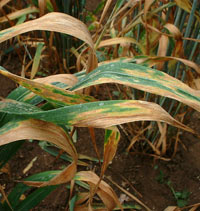‘Keep watch for septoria’

Don’t underestimate the importance of flag leaf wheat fungicides even though septoria pressure appears to be low, says Bill Clark, director of Broom’s Barn Research Centre.
Septoria’s latent period can catch people out as the disease develops inside leaves for 10 days before symptoms start to show, he says. “Leaves can be full of infection and still look green.”
Growers who applied T1 early are most likely to be at risk from septoria attack, he says. “In some cases leaf three was not fully emerged when T1 fungicides were applied and these sprays will have had very little effect.” However, those who used chlorothalonil at T1 will be in a better situation, he notes.
Where there are any signs of infection on lower leaves during flag leaf emergence, even a small amount on leaf tips, the T2 should be sprayed as soon as possible, he says. “The chances are leaf two and the flag leaf will already be infected.”
If spraying T2 early, chlorothalonil should be used as it “splashes around” and protects the emerging flag leaf. “I would recommend applying a 1 litre/ha of Bravo (chlorothalonil) plus a three-quarter rate of Opus (epoxiconazole) or Proline (prothioconazole).“
At normal T2 timing, when the flag leaf is fully emerged, effective eradicant activity is required in the form of a good triazole used at a robust rate, he says. “You need a three-quarter rate of a premium azole, or higher for other azoles – purely protectant chlorothalonil will contribute little.”
Flag leaf emergence is likely to be a week later than in most years but some very early crops will be sprayed this week, he says. “The bulk will probably take place in a week to 10 days’ time.”
Keeping the gap between T1 and T2 to no more than three to four weeks is crucial, even if this means spraying before the flag leaf is fully emerged, says ProCam technical director David Ellerton.
“It’s not ideal to spray before the flag leaf is fully out (GS37), but it’s better than letting septoria take hold,” he says. “If you add chlorothalonil it will help protect the unemerged leaf.”
Cold and dry conditions haven’t been conducive to disease pressure so far with relatively low yellow rust activity and just a handful of mildew reports. But a return to warmer, wetter weather could rapidly change the situation, he says.
“The flag leaf spray contributes the most to final yield and it’s important for the top leaves to be well protected. I would still advise all growers to apply a reasonably robust treatment of a strobilurin and triazole.”
Tod Hunnisett, agronomist for Chichester Crop Consultancy in Hampshire, agrees that septoria is the main concern at T2, but due to low disease pressure in his area, he will be cutting back on fungicide inputs. “I normally recommend a 70-80% triazole rate, but this year I will be cutting back to 55-65%”
Most crops didn’t receive a T0, but were treated with a robust T1 at normal calendar timing, he says.
• For advice on getting the most out of your sprays and sprayers at T2 see our video with Syngenta application specialist Tom Robinson at www.fwi.co.uk/t2spraying

